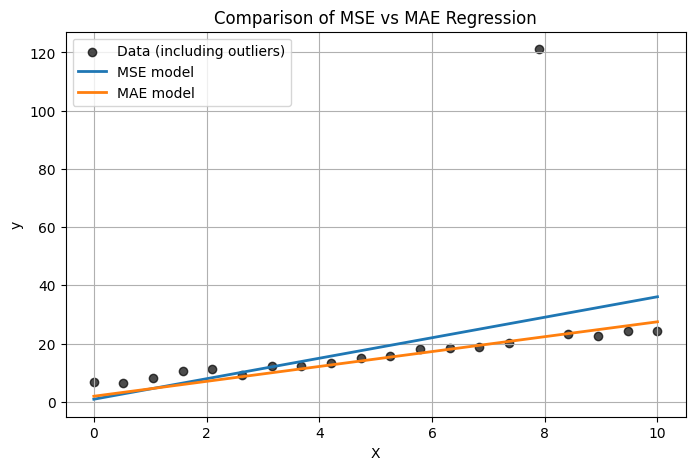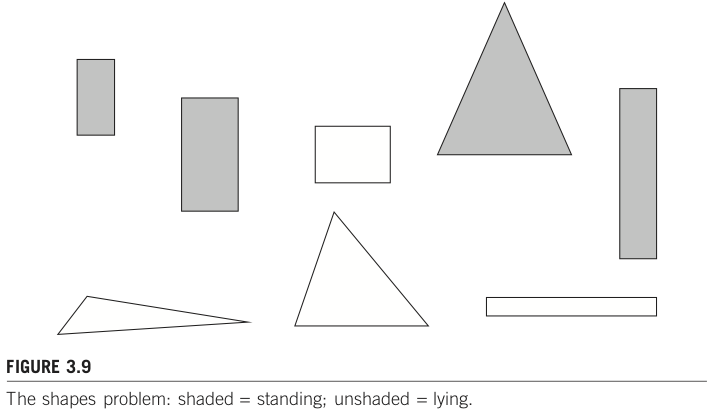MSE vs MAE 回帰モデル比較#
このノートブックでは、線形回帰モデルを以下の2種類の損失関数で学習し、外れ値の影響を比較します。
MSE (Mean Squared Error; 二乗誤差)
MAE (Mean Absolute Error; 絶対値誤差)
MSE は外れ値があるとその影響をより強く受け、MAE は外れ値に比較的ロバストな挙動を示します。
# ライブラリ読み込み
import numpy as np
import matplotlib.pyplot as plt
from sklearn.linear_model import SGDRegressor
# 疑似データセット生成用関数の定義
def generate_linear_data(
num_samples=50, # データのサンプル数
slope=2.0, # 真の直線(傾き)
intercept=5.0, # 真の直線(切片)
noise_std=1.0, # ノイズの標準偏差
num_outliers=2, # 外れ値の個数
outlier_magnitude=40.0, # 外れ値をどの程度離れた位置に置くか(大きいほど離れる)
random_seed=42 # 乱数シード
):
"""
線形回帰モデルの例として、外れ値を含む疑似データを生成する関数。
Returns
-------
X : ndarray (shape: (num_samples,))
入力データ(説明変数)
y : ndarray (shape: (num_samples,))
出力データ(目的変数)
"""
np.random.seed(random_seed)
# Xを0から10まで等間隔に生成
X = np.linspace(0, 10, num_samples)
# 真の線形関係 + ガウスノイズ
y = slope * X + intercept + np.random.randn(num_samples) * noise_std
# 外れ値をランダムに選んだサンプルに付与
outlier_indices = np.random.choice(num_samples, size=num_outliers, replace=False)
for idx in outlier_indices:
y[idx] += outlier_magnitude
return X, y
# データ生成と MSE vs MAE 回帰モデルの可視化
num_samples = 20 # サンプル数
num_outliers = 1 # 外れ値の個数
# 1. データ生成
X, y = generate_linear_data(
num_samples=num_samples, # サンプル数
slope=2.0, # 真の傾き
intercept=5.0, # 真の切片
noise_std=1.0, # ノイズのばらつき
num_outliers=num_outliers, # 外れ値の個数
outlier_magnitude=100,# 外れ値の大きさ
random_seed=0 # 乱数シード(固定生成)
)
# 2. MSE (二乗誤差) モデルの学習
model_mse = SGDRegressor(
loss='squared_error', # MSE
max_iter=1000,
tol=1e-3,
random_state=0
)
model_mse.fit(X.reshape(-1, 1), y)
# 3. MAE (絶対値誤差) モデルの学習
# ただし epsilon_insensitive で代替
model_mae = SGDRegressor(
loss="epsilon_insensitive", # ≒ epsilon=0.0とすることでMAE相当
epsilon=0.0, # 絶対値損失に近くなるように epsilon=0
max_iter=1000,
tol=1e-3,
random_state=0
)
model_mae.fit(X.reshape(-1, 1), y)
# 4. 予測および可視化
X_plot = np.linspace(0, 10, 100)
y_pred_mse = model_mse.predict(X_plot.reshape(-1, 1))
y_pred_mae = model_mae.predict(X_plot.reshape(-1, 1))
plt.figure(figsize=(8, 5))
plt.scatter(X, y, color='black', alpha=0.7, label='Data (including outliers)')
plt.plot(X_plot, y_pred_mse, label='MSE model', linewidth=2)
plt.plot(X_plot, y_pred_mae, label='MAE model', linewidth=2)
plt.title('Comparison of MSE vs MAE Regression')
plt.xlabel('X')
plt.ylabel('y')
plt.legend()
plt.grid(True)
plt.show()
# 5. 回帰係数の確認
print('--- MSE (squared_error) ---')
print(f'Coefficient (slope): {model_mse.coef_[0]:.3f}')
print(f'Intercept: {model_mse.intercept_[0]:.3f}')
print('\n--- MAE (absolute_error) ---')
print(f'Coefficient (slope): {model_mae.coef_[0]:.3f}')
print(f'Intercept: {model_mae.intercept_[0]:.3f}')

--- MSE (squared_error) ---
Coefficient (slope): 3.521
Intercept: 0.858
--- MAE (absolute_error) ---
Coefficient (slope): 2.558
Intercept: 1.882


